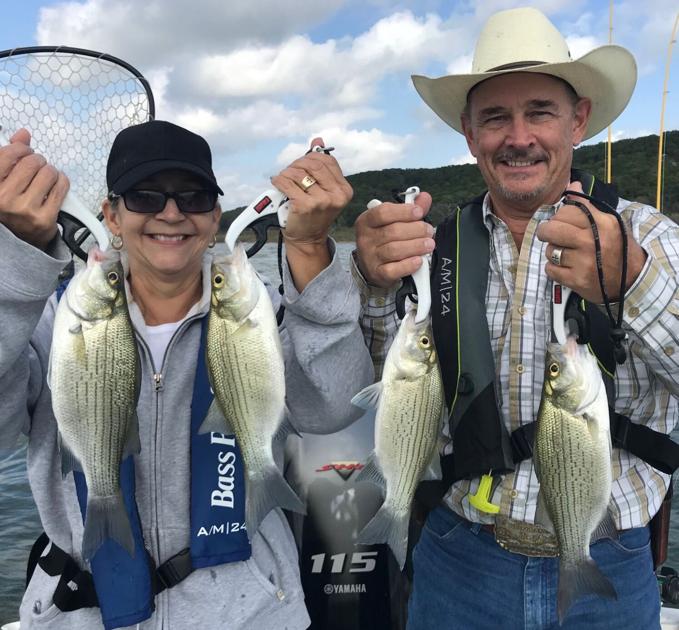
Just when it seems things could not get much better on our two local reservoirs, Belton and Stillhouse Hollow lakes, yet another enhancement to fishing should be appearing shortly in the form of fish-eating migratory birds.
Thanks to a resurgence of warm weather since Labor Day, the falling water surface temperature has stalled in the low to mid-70s, and thanks to abundant forage and ample water levels, the post-turnover fishing has been off to an amazingly productive start. Fish counts for white bass were easily in the 100-plus fish range this week with fish aggressively pursuing fast retrieves and moderately-sized baits.
The weatherman indicates that we are in for a significant cooldown this coming week following Friday’s mild cold front. Although fish activity will drop off with water temperature, the truly cold weather’s arrival will bring with it migratory, fish-eating birds which have been feeding on large bodies of water north of us all summer.
Gulls, terns, loons, kittiwakes, ospreys, eagles and herons will move through Central Texas in abundance all winter, but the start of that migration is just days away. In fact, coots are already beginning to cover down over top of hydrilla patches on Stillhouse, and several mature bald eagles have been spotted around Union Grove Park.
On Wednesday morning while fishing Belton Lake, I spotted several hundred ring-bill gulls in V-shaped flocks of about 20 birds each flying southeast over the lake in the few minutes between first light and sunrise.
Eventually, we will be treated to a resident population of gulls and terns on Belton and Stillhouse which will typically remain here through mid-March.
These birds have extremely sharp eyesight and work together to patrol hundreds of acres of water efficiently, searching for dead and wounded shad which have been killed or injured by gamefish. From time to time, gamefish will force schools of shad to or near the surface and feed on these nutrient-rich forage fish after trapping them against the surface.
Anglers tuned in to this bird activity can significantly reduce the amount of time spent searching for active fish by looking for these birds and fishing where they indicate the presence of gamefish.
I always have a 12-power spotting scope at the ready on my guide boat so I can scan for bird activity and so I can closely study bird activity once it has been spotted.
Just because birds are present is no guarantee that biting fish are nearby. Reading the birds becomes a must.
Here is what to look for and how to avoid being fooled by false positives from our feathered friends.
In all that follows, remember, gulls and terns do not dive beneath the water to catch food. They rarely go more than a half of a body’s length beneath the surface to catch the fish they eat. So, baitfish must be at or within inches of the surface for these birds to feed successfully.
Birds on patrol
When you see gulls or terns flying 80 or more feet above the water’s surface heading in a straight line and flying roughly abreast of one another, you are seeing birds on patrol. These birds are working together to find fish, but they have not yet found what they are after. As a fisherman, such bird activity does not do you much good.
Birds napping
Birds seen in large numbers standing on the shoreline, often with heads tucked under one of their wings is a sign of resting birds which have come to roost for the night or which have yet to leave the roosting area in the morning. Gulls and terns will roost and rest many miles from their feeding grounds, so the presence of birds standing on the shoreline is not really a sign that gamefish are also in the area.
Birds digesting
Oftentimes either before feeding or after feeding, gulls and terns will rest in the water in small groups with birds of their own kind. This is also not helpful to anglers, as it means once available forage is no longer available because it is not near enough to the surface to be plucked from the water with the birds’ beaks. These birds will remain in the area for an hour or so alert to a reoccurrence of the fish activity which they have previously experienced.
Birds circling and striking the water
My adrenaline level starts rising when I see gulls and terns circling over a small, distinct patch of water — perhaps an acre or so in size. These circling birds have found baitfish being forced to or near the surface by hungry gamefish below and are awaiting their chance to seize shad which come within inches of the surface. When one of these circling birds actually folds its wings, dives down and strikes the water, you can know with certainty that gamefish are present.
Once an area holding gamefish is located, well-tuned sonar can be used to efficiently home in on exactly where large congregations of fish are located. Oftentimes, smaller fish will rise up off bottom more willingly than larger, older fish, so although the birds will help you get close, sonar will help to seal the deal.
Given the severity of the cold front due to move through Central Texas this coming Monday around mid-day, and the northerly winds due to blow the entire week, we will almost certainly see the first few birds which will remain resident through the winter arrive this week. Be ready.
Yes, fishing is for the birds, and the catching is for the fishermen who follow them.
The Link LonkOctober 25, 2020 at 08:00PM
https://ift.tt/35uzVkA
BOB MAINDELLE: Birds can show you where the fish are - The Killeen Daily Herald
https://ift.tt/35JkYuc
Fish
No comments:
Post a Comment